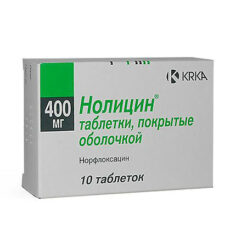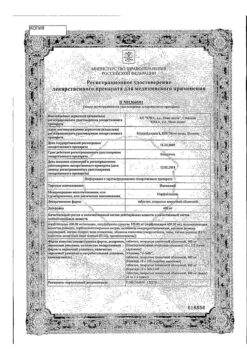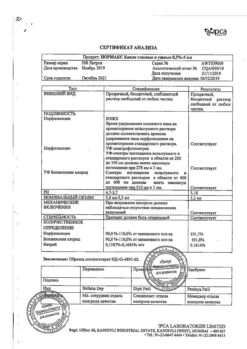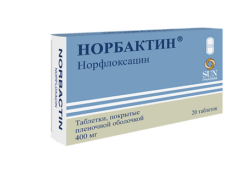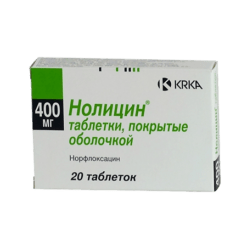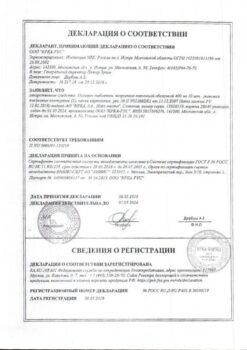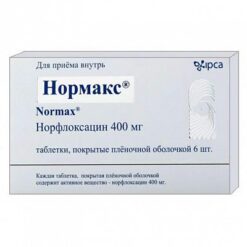No products in the cart.
Norfloxacin, 400 mg 20 pcs
€11.69 €9.74
Description
Pharmaceutical group:
Antimicrobial agent – fluoroquinolone.
Pharmacodynamics:
Antimicrobial agent from the group of fluoroquinolones. It has a bactericidal effect by inhibiting DNA-gyrease, which provides superspiralization and stability of DNA in bacteria, leads to destabilization of DNA chain and death of bacteria.
Norfloxacin is sensitive to in vivo:
Gram-positive aerobes – Enterococcus faecalis, Staphylococcus aureus, Staphylococcus epidermidis, Staphylococcus saprophyticus, Streptococcus agalactiae; Gram-negative aerobes – Citrobacter freundii, Enterobacter aerogenes, Enterobacter cloacae, Escherichia coli, Klebsiella pneumoniae, Neisseria gonorrhoeae, Proteus mirabilis, Proteus vulgaris, Pseudomonas aeruginosa, Serratia marcescens.
They are sensitive to norfloxacin in vitro:
Gram-negative aerobes – Citrobacter diversus, Edwardsiella tarda, Enterobacter agglomerans, Haemophilus ducreyi, Klebsiella oxytoca, Morganella morganii, Providencia alcalifaciens, Providencia rettgeri, Providencia stuartii, Pseudomonas fluorescens, Pseudomonas stutzeri;
others – Ureaplasma urealyticum.
The drug is inactive against obligate anaerobes.
Pharmacokinetics:
Absorption when ingested is fast (30-40%), food reduces absorption. Maximum plasma concentrations (Cmax) of norfloxacin with administration of 200 mg, 400 mg and 800 mg are 0.8 µg/ml, 1.5 µg/ml and 2.4 µg/ml, respectively. Time to reach maximum plasma concentration (TCmax) is 1 h. Effective half-life (T1/2) is 3-4 h. Equilibrium concentration of the drug in blood plasma (Css) is reached within 2 days.
In elderly patients excretion is delayed (due to age-related reduction of renal function): after oral administration of 400 mg of norfloxacin the area under pharmacokinetic curve of drug concentration as a function of time (AUC) is 6.97-12.63 mg*h/ml and Cmax is 1.25-2.79 µg/ml (in young patients – 6.4 mg*h/ml and 1.5 µg/ml, respectively), T1/2 is 4 hours.
The binding to plasma proteins is 10-15%.
In chronic renal failure (CKD) (creatinine clearance (CK) less than 30 ml/min/1.73 sq.m), T1/2 is prolonged to 6.5 h.
Norfloxacin is metabolized in the liver. Renal clearance is 275 ml/min. During 24 hours 26-32% is excreted by kidneys as unchanged substance, 5-8% – as slightly active metabolite. Thereafter less than 1% of the dose is excreted by the kidneys. About 30% is excreted in the intestine. In elderly patients 22% of norfloxacin is excreted by the kidneys (renal clearance – 154 ml/min).
Two to three hours after oral administration of 400 mg the urinary concentration exceeds 200 mcg/ml, within 12 hours it is maintained above 30 mcg/ml. At pH 7.5 the solubility of norfloxacin decreases.
Indications
Indications
Infections caused by Norfloxacin-sensitive strains of microorganisms.
Urinary tract infections:
– Uncomplicated urinary tract infections (including. cystitis) caused by Enterococcus faecalis, Escherichia coli, Klebsiella pneumoniae, Proteus mirabilis, Pseudomonas aeruginosa, Staphylococcus epidermidis, Staphylococcus saprophyticus, Citrobacter freundii, Enterobacter aerogenes, Enterobacter cloacae, Proteus vulgaris, Staphylococcus aureus or Streptococcus agalactiae in the absence of an alternative treatment option;
– complicated urinary tract infections caused by Enterococcus faecalis, Escherichia coli, Klebsiella pneumoniae, Proteus mirabilis, Pseudomonas aeruginosa or Serratia marcescens.
Sexually transmitted diseases (see Precautions): Uncomplicated urethral and cervical gonorrhea caused by Neisseria gonorrhoeae.
Prostatitis caused by Escherichia coli.
Active ingredient
Active ingredient
Composition
Composition
Film-coated tablets.
For 1 tablet:
Norfloxacin – 400 mg
Associates
[Colloidal silica (aerosil)- 7.2 mg
magnesium stearate – 7.2 mg
microcrystalline cellulose – 240.8 mg
croscarmellose sodium – 21.6 mg
crospovidone] – 43.2 mg
i>Average weight of the uncoated tablet – 720 mg
Shell excipients
hypromellose (hydroxypropyl methylcellulose) -13.14 mg
Hypromellose (hydroxypropyl methylcellulose) -13.14 mg/p>
Macrogol 6000 (polyethylene glycol 6000) – 4.4 mg
Titanium dioxide – 4.4 mg
Quinoline yellow dye – 0.06 mg.
How to take, the dosage
How to take, the dosage
Intravenously.
In urinary tract infections – 400 mg 2 times a day for 7-10 days; in uncomplicated cystitis – 3-7 days; in chronic recurrent urinary tract infection – up to 12 weeks.
In acute bacterial gastroenteritis – 5 days.
In acute gonococcal urethritis, pharyngitis, proctitis, cervicitis – once 800 mg.
In typhoid fever – 400 mg 3 times a day for 14 days.
For prevention of sepsis – 400 mg 2 times a day.
For prophylaxis of bacterial gastroenteritis – 400 mg/day.
To prevent travelers’ diarrhea, 400 mg/day 1 day before departure and for the entire period of travel (not more than 21 days).
To prevent recurrent urinary tract infections, 200 mg/day.
In patients with impaired renal function at CK values over 20 ml/min do not require dosage adjustment. In patients with CKD less than 20 ml/min (or serum creatinine concentration more than 5 mg/100 ml) and in patients undergoing hemodialysis a 1/2 of therapeutic dose 2 times a day or a full dose 1 time daily is administered.
Interaction
Interaction
Reduces theophylline clearance by 25%, so if used concomitantly, theophylline dose should be reduced.
Enhances serum concentrations of indirect anticoagulants, cyclosporine.
Decreases the effectiveness of nitrofurans.
The simultaneous use of antacids containing aluminum or magnesium hydroxide, as well as medications containing Fe, Zn2+, sucralfate, reduces absorption of norfloxacin (interval between doses must be at least 4 hours).
The concomitant use with medicinal products (drugs) which lower the threshold of seizure readiness (including non-steroidal anti-inflammatory drugs) may lead to seizures.
Norfloxacin in vitro inhibits the CYP1A2 isoenzyme, which may lead to increased concentrations of its substrates in blood (including caffeine, clozapine, ropinirole, tacrine, theophylline, tizanidine).
In concomitant administration with glibenclamide, severe hypoglycemia may occur.
Probenecid may decrease excretion of norfloxacin.
Antacids, sucralfate, multivitamins containing zinc, didanosine should be taken 2 hours before or 2 hours after taking norfloxacin (may decrease its absorption).
Contraindications
Contraindications
Side effects
Side effects
Central nervous system (CNS) disorders: dizziness, headache, tingling in the fingers, drowsiness, anxiety, depression, insomnia, sleep disturbance.
Digestive system disorders: nausea, abdominal pain, anorexia, diarrhea, pain in the rectum or anus, constipation, dyspepsia, flatulence, vomiting, dry oral mucosa, heartburn, loose stool, bitter taste in the mouth, oral mucosa ulceration, anus itching.
Hematopoietic disorders: leukopenia, thrombocytopenia, eosinophilia, neutropenia.
Skin disorders: itching, rash, erythema, urticaria.
Sensory organs: blurred vision.
Musculoskeletal disorders: bursitis, swollen hands and feet.
Cardiovascular system (CVS): myocardial infarction, palpitations.
Urinary system disorders: renal colic.
Laboratory parameters: increase of AST, ALT, ALT, LDH activity, proteinuria, decrease of hematocrit and Hb, increase of urea concentration in blood, hypercreatininemia, glucosuria.
Others: hyperhidrosis, asthenia, back pain, fever, chills, chest pain, dysmenorrhea, edema, allergic reactions.
Postmarketing experience.
CNS disorders: seizures, myoclonia, tremor, peripheral neuropathy, Guillain-Barré syndrome, ataxia, paresthesia, hypoesthesia, psychiatric disorders (including confusion).
Allergic reactions: anaphylactoid reactions, angioedema, dyspnea, vasculitis, arthritis, arthralgia, myalgia.
Skin disorders: toxic epidermal necrolysis, Stevens-Johnson syndrome, erythema multiforme, exfoliative dermatitis, photosensitization.
Digestive system disorders: pseudomembranous colitis, hepatitis, cholestatic jaundice, pancreatitis, stomatitis, liver failure (including fatal).
Systemic reactions: prolongation of QT interval, ventricular arrhythmia, including pirouette-type tachycardia.
Urinary system disorders: interstitial nephritis, renal failure.
Musculoskeletal system: tendinitis, tendon rupture, exacerbation of myasthenia gravis, increased CPK activity.
Hematopoietic disorders: agranulocytosis, hemolytic anemia.
Sensory organs: decreased hearing, tinnitus, diplopia, dysgeusia.
Other side effects of quinolones: albuminuria, candiduria, crystalluria, cylinduria, dysphagia, hyperglycemia, hypercholesterolemia, hyperkalemia, hypertriglyceridemia, hematuria, liver necrosis, hypoglycemia, nystagmus, postural hypotension, lengthening of SP, vaginal candidiasis.
Overdose
Overdose
Symptoms of overdose: dizziness, nausea, vomiting, drowsiness, “cold” sweat, puffy face without changes in basic hemodynamic parameters.
Treatment:Gastric lavage, adequate hydration therapy with forced diuresis. Examination and observation in hospital for several days is required. There is no specific antidote.
Pregnancy use
Pregnancy use
Adequate and well-controlled studies in pregnant women have not been conducted. Norfloxacin should be used during pregnancy only if the potential benefit justifies the potential risk to the fetus.
It is not known whether norfloxacin is excreted with breast milk. Because other drugs in this class are secreted with breast milk, and because of the possibility of serious adverse reactions in breastfed infants, a decision should be made to discontinue breastfeeding or to discontinue norfloxacin, given its importance to the mother.
Similarities
Similarities
Additional information
| Shelf life | 2 years. |
|---|---|
| Conditions of storage | The drug should be stored at a temperature not exceeding 25 ° C in a place out of the reach of children. |
| Manufacturer | Alium JSC, Russia |
| Medication form | pills |
| Brand | Alium JSC |
Other forms…
Related products
Buy Norfloxacin, 400 mg 20 pcs with delivery to USA, UK, Europe and over 120 other countries.


